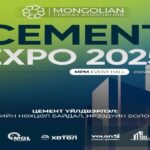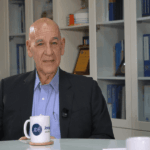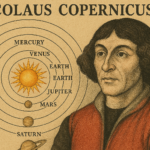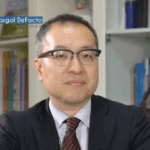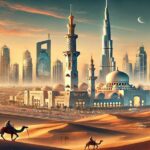“E-Slinky,” Enkhbold replied when I asked him what his dog’s name was. A Korean friend found a puppy on a trip to the countryside a few years ago. The conceptual artists didn’t want to leave it behind. Enkhbold, remembering his former four-legged friend, kept the little furry companion, and the artist’s son, Enkhmanlai, gave him that name.
A resounding “Woof” rings through the January air as we enter the courtyard. E-Slinky is a young dog with a shiny black coat of medium length. Its ears are erect and fall elegantly at their tips. The dog is tied to his post and wags his plush tail. He curiously assesses my palm. I think he approves.
E-Slinky is “cool” in a postmodern way. Even in the presence of his master, he seems to prefer to draw his own conclusions. The dog watched us vigilantly as Enkhbold showed us the frozen camel skins scattered around the yard. They were dipped in a copper dye made from the earth of his native region, Uvurkhangai province.
The artist took out various finds from his stash and displayed them with great pleasure, like a child proudly showing his toys to a guest. What to me and E-Slinky looked like a chaotic pile of random trash was to Enkhbold a goldmine. An artist can see the marvelous in what others do not see.
“Mining 2024” is Enkhbold’s fifth solo exhibition in the series of the same name. The first took place about ten years ago. The author organizes them periodically, every three or four years. The central theme is the preservation of the natural environment and nomadic heritage, which is a traditional source of cultural values for the Mongolian people. The postmodern aspect of Enkhbold’s work is manifested by the awareness of his role as a creator in a developing country and his involvement in a society in perpetual movement.
Dyed camel skins mounted on three-metre-high metal panels form an eight-part installation. Its title translated from Mongolian “The stranded in a wasteland”, which literally means “…without a master in an empty steppe”. Duldegsed is a word coined by Enkhbold. It is associated with other Mongolian words such as “abandoned”, “abandoned”, “left behind”, “lost”, “deaf”, “wanderer”.
The malleability of the camel skins attached to the inflexible scrap iron seems to emphasize the fragility of nature in contrast to man’s relentless pursuit of progress, the indelible traces he leaves behind on his path of advancement. The artist’s concern for the environment seems to shine through in the warm red-orange hue of the organic material, which contrasts sharply with the silver-gray color of the artificial shields.
The centerpiece of the installation is a forward-leaning staircase that leads to a satellite dish. “I imagine it as a mirror,” says Enkhbold. The installation’s environment reflects uncertainty about the purpose of seemingly rational human activities.

In the far right corner of the composition, a roll of rawhide wrapped in rusty bandsaw blades sits vertically. The red cables protruding from the camel skin stylistically match the ribbon. This construction evokes serious injuries for the viewer. The rusty saw blades and wire used to wrap and suture the once-living skin suggest some kind of artificial force that prevents the natural decomposition of organic matter. Contrasting materials alternate, creating layers separated from each other by bolts and hooks. Visitors can move freely around the eight panels and pass between them. The shades of light reflected by the layers of materials reinforce the visual effect of “The Stranded in a Wasteland” and its interactive experience.
The formation of spatial awareness in the viewer is one of the benefits of the exhibition and installation art in general. The sense of space is an important leitmotif in Enkhbold’s work, installations, performances, paintings, conceptual works and experiments.

The visual poetry of Enkhbold’s abstract paintings is mesmerizing. He paints them with colors based on inorganic and organic pigments such as earth, soot, manure, rust and dried grass. He often embosses his paintings with animal hoof prints, markings, applications of animal organ sheaths or antique objects. All these works seem to infuse the spirit of ancient nomads and radiate the warmth of the earth. The visual topography of monochrome tones catches the eye, as if the relief patterns tell the story of nomadic ancestors who lived in a time when man and nature coexisted in peace and harmony. Respect for nature is the main aspect of the traditional education of nomads. In the artist’s abstractions there is a symbolic gesture of benevolence towards the animate and inanimate forms of nature. The spatial harmony, the consistency of earthy colors present in Enkhbold’s abstractions create an anchoring effect, thanks to which we have the feeling of a return of energy and natural balance.

Enkhbold participated in an exhibition residency in Rotterdam, the Netherlands, in 2009 organized by Finnish curator, Annu Wilenius. Like a true nomad, he made his first serious artistic journey, taking with him a carefully packed gé (yurt). Among strangers, in a country whose language he did not know, Enkhbold and his little manager conducted conceptual experiments and public performances for three months. This trip had a lasting impact on him. The experience he gained still serves as an inspiring spark for him today. “When I created my performances there, the influence of the sea and the energy of the people seemed different to me,” Enkhbold recalls.

The sense of space, whether geographic, physical, cultural or relational, as well as the concept as a whole, becomes flexible and fluid depending on the environment in which the artist works. The traditional understanding of space and its vastness by Mongolian nomads faces a contradictory perception in urban environments where concepts such as privacy, property, rules and order are prioritized by people. Enkhbold’s performances reflect these paradoxes of human existence. They can also be interpreted as an act of homage to the home – the spiritual focus of the interior in the management .
Enkhbold and his wife, the artist L. Munguntsetseg, have three young children. “As a father, I worry about the state of the ecological environment that my children will inherit when they grow up. That is why one of the goals of my art is to develop an appreciation of nature and a awareness of its fragility. I am convinced that nature is the only source of life for the body and soul of man. With this exhibition, I want to show that the link between man and nature should not not be destroyed, but rather cultivated with care,” Enkhbold said.
The boom in mining and the consumer economy is rapidly changing Mongolian society and raising many pressing questions. As man himself is part of living nature and has the power to create and destroy, the exhibition entitled “Mining” offers a special perspective on the concept of mining.
Thinking about how to preserve traditional nomadic wisdom about the land in order to continue the harmonious exchange between man and nature gives rise to the following thought: the progress we aspire to can become so meaningless if, in this process, irreparable damage is caused to humanity and the natural source. This thought seems to be the invisible thread that connects E-Slinky, the “mirror” and us.
Photo 1: Artist T. Enkhbold (right) and throat singer and leader of the “Domog” group B. Bat-Orshikh at the opening of the exhibition.
by J. Ariunaa
Published in the UB Post
January 24, 2024


